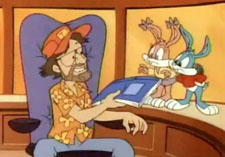 Nickelodeon Series That Never Were. In 1991, Nickelodeon tested several animated pilot films that never made it to air. One was Weasel Patrol based on the delightful stories by Ken Macklin and Lela Dowling appearing in fourteen issues of the Eclipse comic book Fusion.
Nickelodeon Series That Never Were. In 1991, Nickelodeon tested several animated pilot films that never made it to air. One was Weasel Patrol based on the delightful stories by Ken Macklin and Lela Dowling appearing in fourteen issues of the Eclipse comic book Fusion.
Cosgrove Hall had submitted both Trash, a model animated show about space travelers stuck on a planet of trash and Crowville Chronicles about a small town newspaper with a crow as the star reporter done in traditional animation. Aardman also submitted a model animated pilot entitled Hamilton Mattress about an aardvark. Big Beast Quintet was based on the then Nickelodeon ID of five animals marching along singing doo-wop and rearranging to spell out “Nickelodeon”.
None of them tested well with a kids’ audience. Nickelodeon instead selected Rugrats, The Ren and Stimpy Show described as “classic cartoon madness taken to the cutting edge” in the publicity release and Doug. “We hope to change the face of animation,” said Geraldine Laybourne president of Nickelodeon/Nick at Nite.

 Margaret Winkler. When we talk about women in animation, Margaret J. Winkler (1895-1990) seems to be often forgotten. In Exhibitor’s Herald December 20, 1922, she said, “I think the industry is full of wonderful possibilities for an ambitious woman and there is no reason why she shouldn’t be able to conduct business as well as the men.” She entered the film industry in 1914 as a private secretary to Harry M. Warner.
Margaret Winkler. When we talk about women in animation, Margaret J. Winkler (1895-1990) seems to be often forgotten. In Exhibitor’s Herald December 20, 1922, she said, “I think the industry is full of wonderful possibilities for an ambitious woman and there is no reason why she shouldn’t be able to conduct business as well as the men.” She entered the film industry in 1914 as a private secretary to Harry M. Warner.
She met Charles B. Mintz at Warner Brothers in 1915 and they married in 1923. She had formed an independent company in February 1922 with the aim of building a business on “states rights” distribution.
Besides distributing animated cartoons by Pat Sullivan, Max Fleischer and Walt Disney, she also distributed Burton Holmes Travelogues and a series called Memories purportedly based on popular song titles. She scheduled Fleischer’s Out of the Inkwell with Koko the Clown and Sullivan’s Felix the Cat to be released on alternate weeks throughout the 1922-23 season and advertised them heavily in the trade press with illustrations of the characters speaking directly to the exhibitor.
The legal battles with Pat Sullivan over Felix the Cat and Walt Disney’s struggles with Oswald the Lucky Rabbit created great stress for her. Margaret retired from the company in 1925 to raise her daughter Kathryn. Also in 1925, her husband Charles entered into film production with the animated Krazy Kat series and live action Reg’lar Kids shorts.
 Nick Park Speaks. In a 1991 British newspaper interview, animator Nick Park said, “I’ve tried to appeal to something in myself as an adult and at the same time appeal to what I wanted to see as a child like building a rocket with a cozy room and going somewhere (in A Grand Day Out)…and being able to believe in it. That’s what a lot of children’s things lacked for me as a child.
Nick Park Speaks. In a 1991 British newspaper interview, animator Nick Park said, “I’ve tried to appeal to something in myself as an adult and at the same time appeal to what I wanted to see as a child like building a rocket with a cozy room and going somewhere (in A Grand Day Out)…and being able to believe in it. That’s what a lot of children’s things lacked for me as a child.
“As an adult, I like comedy. I like the ridiculous. I also like melodrama. But it’s got to have a sense of realism as well. My goal is to entertain in a different way from what people think is model animation.
“You’re not directing somebody else. You are creating the performance. You tend to be very much in touch with what’s going on. People seem to like things that are well observed. They see something of themselves in them.”
 Wisdom of Katzenberg. In a 1991 issue of Variety, Disney Studios Chairman Jeffrey Katzenberg said, “There’s nothing that I get to do in my job that I love more than animation. These people have seduced me into their world. All movies involve imagination but animated films are the only ones that involve pure imagination because you start with a blank slate and must create everything in that environment. An incredibly magical process.
Wisdom of Katzenberg. In a 1991 issue of Variety, Disney Studios Chairman Jeffrey Katzenberg said, “There’s nothing that I get to do in my job that I love more than animation. These people have seduced me into their world. All movies involve imagination but animated films are the only ones that involve pure imagination because you start with a blank slate and must create everything in that environment. An incredibly magical process.
“Animation is the heart and soul of Disney. It may not produce the greatest profits but it is the most important financial center of the company. It’s not possible to put a price tag on it.”
Katzenberg said Disney was still committed to release one new animated feature a year and among the projects in development were an adaptation of the Swan Lake story, Tim Rice’s Dragons, Humphrey the Whale, Tiny the Alligator (a “growing up story” of a resident of New York City who happens to be the size of an 18-wheeler), Baba Yaga (the Russian folk tale written by Dale Wasserman who wrote the stage musical Man of La Mancha) as well as Beauty and the Beast and King of the Jungle (that became The Lion King).
 The Occasional Cannon. From the L.A. Daily News March 25th, 1991, Jean MacCurdy, vice president and general manager of Warner Brothers said this about Tiny Toon Adventures: “(Steven Spielberg) worked closely with us in terms of development of characters, personalities, design, stories and the general look of the series. Everything is ‘okayed’ by him and if he doesn’t like it, he sends us a note. He’s sent a lot of notes. It’s important to Steven that the humor plays on a number of levels.
The Occasional Cannon. From the L.A. Daily News March 25th, 1991, Jean MacCurdy, vice president and general manager of Warner Brothers said this about Tiny Toon Adventures: “(Steven Spielberg) worked closely with us in terms of development of characters, personalities, design, stories and the general look of the series. Everything is ‘okayed’ by him and if he doesn’t like it, he sends us a note. He’s sent a lot of notes. It’s important to Steven that the humor plays on a number of levels.
“There is a similarity between the new characters and the old in appearance and attitude but the new characters have distinct personalities that are very broad so they can carry 65 episodes. I don’t call what we do in the cartoons violence. I call in comedic action or slapstick. And in the whole 65 episodes we’ve had very few complaints from the viewing audience. We deliberately avoid guns, though, that’s especially import to Steven. But the humor is larger than life, in the animation tradition so we do have the occasional cannon.”
Menken on Ashman. In L.A. Weekly April 6th, 1991, composer Alan Menken said about his writing partner Howard Ashman who passed away at the age of 40 in March, “Ashman was the best of his generation at the interface between song and scene. He worked closely with the writers on The Little Mermaid and Beauty and the Beast. He didn’t write a song until he knew how to get from point A to point B. We put in the songs only where we felt it was needed. He kept his energy and passion alive to see the movie through.”
Beauty and The Beast producer Don Hahn has directed a new documentary on the life of Howard Ashman – Here’s the trailer:


 Jim Korkis is an internationally respected animation historian who in recent years has devoted his attention to the many worlds of Disney. He was a columnist for a variety of animation magazines. With his former writing partner, John Cawley, he authored several animation related books including The Encyclopedia of Cartoon Superstars, How to Create Animation, Cartoon Confidential and Get Animated’s Animation Art Buyer’s Guide. He taught animation classes at the Disney Institute in Florida as well as instructing classes on acting and animation history for Disney Feature Animation: Florida.
Jim Korkis is an internationally respected animation historian who in recent years has devoted his attention to the many worlds of Disney. He was a columnist for a variety of animation magazines. With his former writing partner, John Cawley, he authored several animation related books including The Encyclopedia of Cartoon Superstars, How to Create Animation, Cartoon Confidential and Get Animated’s Animation Art Buyer’s Guide. He taught animation classes at the Disney Institute in Florida as well as instructing classes on acting and animation history for Disney Feature Animation: Florida.




















































The failed pilots look almost more appealing than the original 3 Nicktoons (no offense).,
I remember hearing some Tiny Toon animators grousing that Spielberg would never allow Tex Avery-style bulging eyeballs because they “looked like boobs”.
Which is odd, considering Tiny Toons came out right after both Roger Rabbit and the Little Mermaid. After seing those movies, we kids were bummed out when we didn’t get boobs in our cartoons! There should have been a boobs arms race (Boobs race?) among the studios at that time! In fact, he should have just made the character “Boobs Bunny” instead of Babs! Well, at least he got the idea by the time Animaniacs rolled around and included Hello Nurse and Katie Kaboom.
Dangit, now I really want a Weasel Patrol cartoon.
Me too. It would have been great fun.
Would’ve loved to see that. Enjoyed the comics.
I hope someday the Weasel Patrol pilot will surface online, it looked interesting and the late animator Harold Duckett best known for his work at Kennedy Cartoons worked on it.
Nick, nobody was liking Who Framed Roger Rabbit and The Little Mermaid for the breasts; it was the story and characters. What you said is not academic but mastabatory and disrespectful.
Speak for yourself, mac!
Mastaboobtory and dicrespectful.
Yes, NOBODY liked “Who Framed Roger Rabbit” for the sexy design of Jessica Rabbit, just the way NOBODY liked Tex Avery’s “Red Hot Riding Hood” for the sexy design of Red…
Qoute”The legal battles with Pat Sullivan over Felix the Cat and Walt Disney’s struggles with Oswald the Lucky Rabbit created great stress for her. Margaret retired from the company in 1925 to raise her daughter Kathryn. Also in 1925, her husband Charles entered into film production with the animated Krazy Kat series and live action Reg’lar Kids shorts.”/Qoute
1925? Oswald was not created until 1927. So I guess it was only the Felix legal dispute that was causing the stress if it was in 1925. SO if she had been already stressed because of the Felix legal dispute then I suspect the Oswald dispute in 1928 didn’t help eather. But I also wonder on what terms she was with Walt after he lost Oswald. But I have see no accounts regarding the fact.